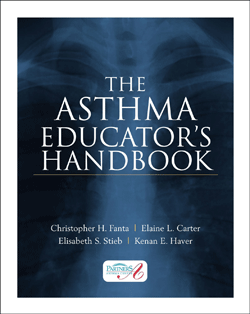Book review: The Asthma Educator’s Handbook

Edited by Christopher H. Fanta, MD, Elaine L. Carter, RN, Elisabeth S. Stied, RN, et al. Whitby, ON: McGraw-Hill Professional, 2007. ISBN-10: 0071447377 ISBN-13: 978-0071447379. Paperback, 304 pages. Price: $61.95.
The authors’ primary purpose for The Asthma Educator’s Handbook is to be a resource that provides the knowledge, skills, and attitude necessary for any health care provider to become an effective asthma educator. Secondary goals for the handbook include providing educators with practical information that is written in patient-friendly terminology and to serve as a study guide for those who wish to write the National Asthma Education Certification Board Examination in the United States.
As such, the handbook provides a thorough review of the basics, including disease pathophysiology, diagnosis and assessment of disease severity, pharmacological treatment information (anti-inflammatory vs. bronchodilator use) and treatment management in both the adult and child populations. In addition, the handbook provides practical aspects of pulmonary function testing, allergy and trigger avoidance strategies, inhaler technique, development of asthma action plans, and management of acute episodes.
Each chapter highlights key points for easy reference and includes self-assessment questions to facilitate exam preparation. The primary source of the handbook is the National Asthma Education and Prevention Program (NAEPP) of the National Institutes of Health’s Expert Panel Report 2: Guidelines for the Diagnosis and Management of Asthma, 1997, and the expert panel’s Update on Selected Topics 2002.
Where scientific evidence may be lacking the authors also include their own clinical experiences. Therefore, a significant drawback to the handbook is that the epidemiological information is based on American statistics, and some of the medications and inhaler devices are not available in Canada.
In addition, the only referencing documented is the listing of the NAEPP Panel Reports in the introductory section. As a result, if further reading of source documentation is required, the reader will need to access the original panel reports to identify the original references.
Other drawbacks include the section titled Are Beta-Agonist Bronchodilators Harmful? in which the authors discuss the findings from the Sameterol Multicenter Asthma Research Trial (SMART) and the use of long-acting bronchodilators (LABAs) in the management of asthma. The authors briefly outline the trial and provide the FDA warning that is associated with the use of LABAs.
There is no mention of the subsequent rebuttals to the findings of the study, and the authors’ response to the information is to recommend the continued use of LABAs only in combination with anti-inflammatory medication “for patients with more than just mild asthma.” In addition, the assessment of disease severity is based on the NAEPP’s set-wise approach to classification and disease management, which differs from the Canadian system of disease classification, but is consistent with the Global Initiative for Asthma (GINA) Workshop Report, Global Strategy for Asthma Management and Prevention, revised 2006. The reports are available on www.ginasthma.org.
The primary audience for The Asthma Educator Handbook is allied health professionals. The text is applicable for people who want to learn about asthma education, but its main purpose is to be a study guide for those individuals who want to write the American Board Examination. Physicians may find the text too simplified, but the practical examples are helpful when trying to explain to patients what asthma is and how it is managed.
Readers can use the text as an adjunct to other sources such as the Canadian Asthma Consensus Report 1999, along with the subsequent updates in 2001 and 2003, and the GINA guidelines. A source (which uses devices available in Canada) for teaching inhaler technique is Using Inhalation Devices from the Comprehensive Management of Chronic Obstructive Pulmonary Disease by J. Bourbeau and colleagues.
In addition, the article “Interpreting pulmonary function tests: Recognize the pattern, and the diagnosis will follow,” by F. Al-Ashkar and colleagues, Cleveland Clinic Journal of Medicine, 2003;7(10) is a concise source for understanding pulmonary function testing.
Currently in Canada there is a certification process for those who wish to become certified respiratory educators. Information about courses and the national examination can be obtained from the Canadian Network for Asthma Care web site, www.cnac.net.
—Susan Attridge, RRT, CRE
Asthma educator

